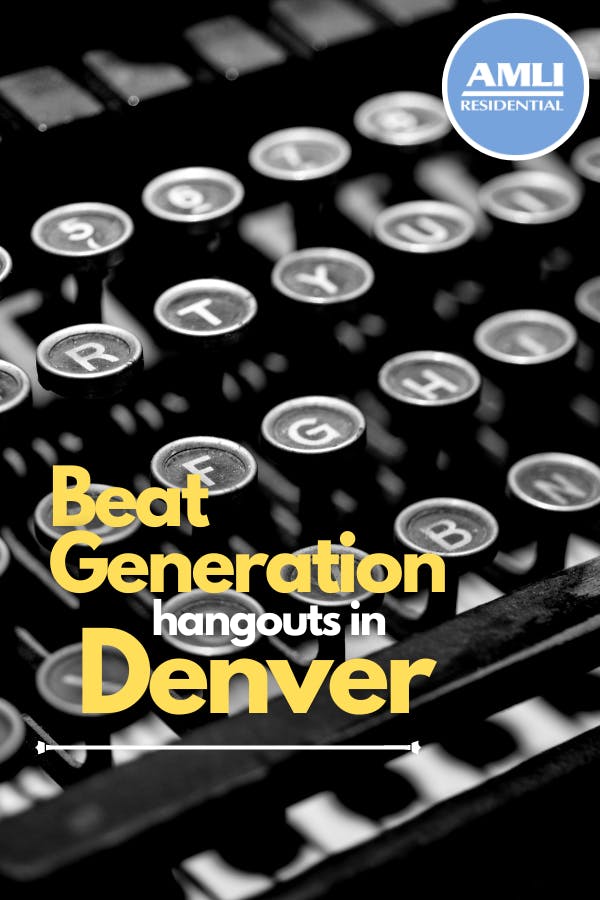“I pictured myself in a Denver bar that night, with all the gang, and in their eyes I would be strange and ragged and like the Prophet who has walked across the land to bring the dark Word, and the only Word I had was 'Wow!” — Jack Kerouac, “On the Road”
Denver featured prominently in the Beat Movement of the 1950s and ‘60s, starting with writer Jack Kerouac’s wildly popular novel “On the Road” published in 1957. In his novel, Kerouac recounts his travels to the Mile High City with his friend, Neal Cassady, and their experiences in the city.
If you want more information on the history of the novel and the city, you can read all about Denver’s significance to the Beat Generation here!
Here are just a few of the places that featured prominently in the Beat era, either in Kerouac’s novel or later during the larger countercultural movement. Many of them are right next to our luxury Denver apartments, too!
Beat-era hangouts in Denver
My Brother's Bar
If you’re only going to visit one Beat-ear spot, let it be this one.
This old school restaurant across the river from Confluence Park was a frequent haunt for Neal Cassady, Jack Kerouac and Allen Ginsberg. It’s also Denver’s oldest taverns and has been serving dreamers, writers and artists since 1873.
Nob Hill Inn
Located on Colfax Avenue just three blocks east of the Capitol, The Nob Hill Inn was another bar frequented by Denver local Neal Cassady. This small, unassuming bar was referenced in his “Joan Anderson Letter” which Cassady sent to Kerouac in the early 1950s — an 18-page frenzied letter written in a tight, cramped style that also came to define Kerouac’s own writing.
Civic Center Park
"Denver! Denver! we'll return roaring across the City & County Building lawn which catches the pure emerald flame streaming in the wake of our auto."
This excerpt from Allen Ginsberg’s “The Green Automobile” alludes to the significance the buildings around Civic Center Park had to this particular Beat poet. According to Ginsbersg, Neal Cassady told him that he spent much of his teenage years at the Denver Public Library (which was then housed in The McNichols Building near the park) reading the works of Immanuel Kant.
Larimer Square
Who wouldn’t want to go to Larimer Square for a countercultural movement?
You’d be surprised.
Today, Larimer Square is an upscale, dreamy paradise with restaurants, shops and entertainment options galore, but back in the 1950s and the decades prior, it was not nearly as aesthetically pleasing.
The then-named Larimer Street was about as seedy and dingy as a place can get, with dive bars, flea-ridden motels and shady characters lurking in liquor-soaked alleyways at every corner. It was here that Neal Cassady spent much of his teenage and adult years, hopping between bars and dodgy motels.
Modern-day Larimer Square looks totally different from Larimer Street in the 1950s, but although the businesses are different and the street’s all cleaned up, the historic buildings are still the exact same ones that Cassady romped around in so many decades ago.
Five Points
The Five Points neighborhood — and Welton Street in particular — was a central location for many Beat-era writers, musicians and artists. Back in the 1950s, it was the beating heart of the city’s jazz scene, a characteristic which continues today!
Sonny Lawson Field, also in the Five Points neighborhood, was mentioned in “On the Road” as a charming field with a wholesome, family-friendly baseball game taking place on the night Jack Kerouac visited. Apparently, it made him feel really, really sad.
The Five Points neighborhood still acts as a cultural, musical and artist hub in Downtown Denver, with sections of RiNo, LoDo, the Ballpark District, Curtis Park and Union Station all overlapping in this vibrant area.
Central City Opera House
Kerouac made the trip out of the city and into the mountains to visit this opera house in 1947, where he attended a concert of Beethoven’s “Fidelio.” It made enough of an impression on him that he described his experience in incredible detail in his novel “On the Road.”
"It was a wonderful night. Central City is two miles high; at first you get drunk on the altitude, then you get tired, and there’s a fever in your soul. We approached the lights around the opera house down the narrow dark street; then we took a sharp right and hit some old saloons and swinging doors ... We started off with a few extra-sized beers. There was a player piano. Beyond the back door was a view of the mountainsides in the moonlight. I let out a yahoo. The night was on."
Allen Ginsberg Library
This wasn’t around during the Beat era, but it’s certainly worth the visit if you’re interested in the Beat Movement.
Allen Ginsburg spent much of his time at Naropa University in the 1970s and ‘80s after he founded the Jack Kerouac School of Disembodied Poetics. True to the mission, the school’s library houses a stunning collection of recordings, artworks and writings from the iconic literary and countercultural movement.
Whether you’re an aspiring beatnik or simply appreciate a good dose of literary history, these Beat-era hangouts in Denver are sure to be a neat slice of city history one way or another. Check out the old restaurants, taverns, bars and parks that once housed these great literary figures and see for yourself how that Denver magic stays alive all these years later.
All there is to say now is…
… The End.
Pin it!

Featured photo courtesy Pixabay/1778011


 View All Posts by Colleen Ford
View All Posts by Colleen Ford